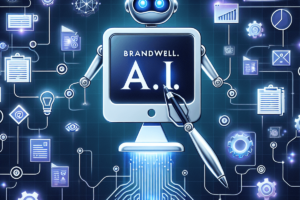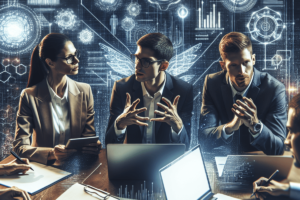AI image generators are a new and exciting technology that allows users to create images from scratch using text descriptions. These generators use artificial intelligence algorithms to analyze the text and generate a corresponding image. Users can choose from different models, styles, and parameters to customize their images and use them for any legal purpose.
The fundamentals of AI image generation involve using machine learning algorithms to analyze and interpret text descriptions and then generate corresponding images. These algorithms use deep learning techniques to learn from large datasets of images and text descriptions and apply this knowledge to generate new images. Popular AI image generator platforms include DeepAI, Fotor, Pixlr, and Kapwing. Each platform offers different features and customization options to suit different user needs.
Applications of AI image generators are vast and varied, ranging from creating artwork and illustrations to generating images for websites and social media posts. AI image generators are also useful for creating product designs and prototypes, as well as for generating images for scientific and medical research. Despite their many benefits, AI image generators face technical challenges and limitations, including accuracy and reliability issues. However, with ongoing research and development, it is likely that these limitations will be overcome in the future.
Key Takeaways
- AI image generators use artificial intelligence algorithms to analyze text descriptions and generate corresponding images.
- Popular AI image generator platforms include DeepAI, Fotor, Pixlr, and Kapwing.
- AI image generators have a wide range of applications, but face technical challenges and limitations that are likely to be overcome in the future.
Fundamentals of AI Image Generation
AI image generators have revolutionized the field of computer vision, enabling the creation of realistic and high-quality images. These generators use complex algorithms and deep learning techniques to synthesize images that are indistinguishable from real ones. In this section, we will discuss the fundamental concepts of AI image generation.
Understanding Generative Adversarial Networks (GANs)
Generative Adversarial Networks (GANs) are a class of neural networks that are widely used in AI image generation. GANs consist of two networks: a generator and a discriminator. The generator produces synthetic images, while the discriminator evaluates the authenticity of the images. The two networks work together in a feedback loop, with the generator trying to produce images that can fool the discriminator, and the discriminator trying to distinguish between real and fake images. This process continues until the generator produces images that are realistic enough to fool the discriminator.
Evolution of Convolutional Neural Networks (CNNs)
Convolutional Neural Networks (CNNs) are a type of neural network that are particularly well-suited for image recognition tasks. CNNs have evolved significantly over the years, with the development of deeper and more complex architectures. These architectures have enabled CNNs to learn more complex features and patterns in images, resulting in better performance in image generation tasks.
Role of Deep Learning in Image Synthesis
Deep learning has played a crucial role in the development of AI image generators. Deep learning techniques such as CNNs and GANs have enabled the creation of high-quality images that are nearly indistinguishable from real ones. Deep learning algorithms can learn from large datasets and can generate images that are highly realistic. As a result, AI image generators have a wide range of applications, from generating realistic images for video games and movies to assisting in medical diagnosis and treatment.
Popular AI Image Generator Platforms
AI image generators are becoming increasingly popular, allowing users to create stunning visuals from plain text input. Here are some of the most popular AI image generator platforms currently available:
Comparing Top Image Generation Services
When it comes to comparing the top image generation services, DALL-E 2 by OpenAI and ImageFX by Google are two of the best AI image generators available in 2024. DALL-E 2 is a great option for those who want to experience the original, while ImageFX is the best AI image generator for beginners.
Features of Cloud-Based Generators
Cloud-based generators are becoming increasingly popular due to their ease of use and accessibility. Firefly by Photoshop is a great option for integrating AI-generated images into photos, while Generative AI by Getty Images is perfect for creating usable, commercially safe images.
Open-Source Image Generator Tools
Open-source image generator tools are a great option for those who want to create AI-generated images without spending a lot of money. Visme’s text-to-image generation tool is free, easy to use, and powerful, generating visuals out of plain text input. DALL-E 3 is another great open-source option, built to craft detailed and lifelike images from your text prompts.
Related Posts:
- AI Image Generator: Turn Text to Images, generative art and generated photos
- Free AI Image Generator: Online Text to Image App | Canva
Applications of AI Image Generators
AI image generators have a wide range of applications across various industries. Here are some of the most prominent ones:
Media and Entertainment Industry
AI image generators have revolutionized the media and entertainment industry by providing a cost-effective and efficient way to generate high-quality images. These generators have been used in creating movie posters, album covers, and other promotional materials. AI image generators have also been used in creating special effects for movies and TV shows.
E-commerce and Advertising
AI image generators have become increasingly popular in the e-commerce and advertising industry. They have been used to create product images, banners, and other promotional materials. AI image generators have also been used in creating personalized advertisements based on the user’s preferences and browsing history.
Educational Purposes
AI image generators have also been used in the education sector. They have been used to create educational materials such as diagrams, charts, and illustrations. These generators have also been used to create interactive learning environments that help students better understand complex concepts.
Scientific Research
AI image generators have been used in scientific research to create visual representations of complex data. They have been used to create 3D models, simulations, and other visualizations that help researchers better understand complex phenomena. AI image generators have also been used to create visual representations of scientific concepts that are difficult to explain with words alone.
Overall, AI image generators have a wide range of applications across various industries. They have revolutionized the way images are created and have provided a cost-effective and efficient way to generate high-quality images. With the continued development of AI technology, we can expect to see even more innovative applications of AI image generators in the future.
Technical Challenges and Limitations
Ethical Considerations and Misuse
One of the major technical challenges of AI image generators is the ethical considerations and potential for misuse. These generators have the capability to produce images that can be used for fraudulent and malicious purposes, such as creating fake identities or spreading disinformation. Therefore, it is important to establish guidelines and regulations for the use of AI image generators to prevent misuse.
Bias in Training Data
Another challenge of AI image generators is the potential for bias in the training data. If the training data is biased, the generated images may also contain bias. For example, if the training data contains predominantly images of one race, the generated images may also be biased towards that race. Therefore, it is important to ensure that the training data is diverse and representative of the population.
Computational Resource Constraints
AI image generators require a large amount of computational resources to generate high-quality images. This can be a challenge for individuals and organizations with limited resources. Additionally, the size of the generated images can be a limiting factor, as larger images require more computational resources. Therefore, it is important to consider the computational resources required when using AI image generators.
In conclusion, while AI image generators have the potential to revolutionize the field of image generation, there are still technical challenges and limitations that need to be addressed. Ethical considerations and potential for misuse, bias in training data, and computational resource constraints are just a few of the challenges that need to be tackled in order to fully realize the potential of AI image generators.
Future Trends in AI Image Generation
As AI technology continues to advance, so too will the capabilities of AI image generators. In the years to come, there are several trends that are expected to shape the future of AI image generation.
Advancements in Neural Network Architectures
One of the key areas of focus for AI image generators is the development of more advanced neural network architectures. These architectures will be capable of generating more complex and detailed images, with greater accuracy and realism. This will be achieved through the use of deep learning techniques, which will allow AI image generators to learn from vast amounts of data and improve their performance over time.
Integration with Other AI Domains
Another trend that is expected to shape the future of AI image generation is the integration of AI image generators with other AI domains. For example, AI image generators could be integrated with natural language processing algorithms to create images based on textual descriptions. This could have applications in fields such as advertising, where images could be generated automatically based on product descriptions.
Societal Impact and Adoption
As AI image generation technology becomes more advanced and accessible, it is likely to have a significant impact on society. For example, AI-generated images could be used to create highly realistic fake images or videos, which could be used for malicious purposes. As a result, there will be a need for regulations and ethical guidelines to ensure that this technology is used responsibly.
Related Posts:
How to Get Started with AI Image Generators
Selecting the Right Tool for Your Needs
When it comes to AI image generators, there are many tools available in the market. It is important to select the right tool that suits your needs. Some of the popular tools are Deep Dream, NeuralStyle, and GANbreeder. It is recommended to do thorough research on the features, capabilities, and limitations of each tool before making a decision.
Learning Resources and Communities
To get started with AI image generators, it is important to have access to learning resources and communities. There are various online courses, tutorials, and forums available that can help you get started. Some of the popular resources are Coursera, Udemy, and Kaggle. It is also recommended to join online communities such as Reddit and GitHub, where you can interact with other enthusiasts and experts.
Building Your First Generative Model
Once you have selected the right tool and have access to learning resources, it’s time to build your first generative model. It is recommended to start with a simple model and gradually move on to more complex models. It is also important to experiment with different parameters and settings to get the desired output. It is recommended to keep a record of your experiments and results for future reference.
In conclusion, getting started with AI image generators requires careful selection of the right tool, access to learning resources and communities, and building your first generative model. With the right approach and mindset, anyone can get started with AI image generators and create stunning images.
Legal and Copyright Issues
Understanding Copyright Laws
Copyright laws protect original works of authorship, including images, from being used without permission. In the context of AI-generated images, copyright laws can become complicated. While AI-generated images may not be exact copies of existing images, they may still be considered derivative works that infringe on the original artist’s copyright.
AI-Generated Content Rights
The question of who owns the rights to AI-generated content is still up for debate. In some cases, the AI itself may be considered the author of the work, while in others, the person or company that created the AI may be considered the author. This can have significant legal implications, as ownership of the work determines who has the right to license and profit from it.
Navigating Licensing Agreements
When using AI-generated images, it is important to carefully review any licensing agreements that come with the software or platform. Some agreements may grant the user full ownership and control over the images they create, while others may restrict the user’s ability to use or profit from the images. It is also important to ensure that any images used in the creation of the AI are properly licensed and do not infringe on any existing copyrights.
Overall, navigating the legal and copyright issues surrounding AI-generated images requires a careful understanding of the relevant laws and licensing agreements. By taking the time to review and understand these factors, users can ensure that they are using AI-generated images in a way that is both legal and ethical.















